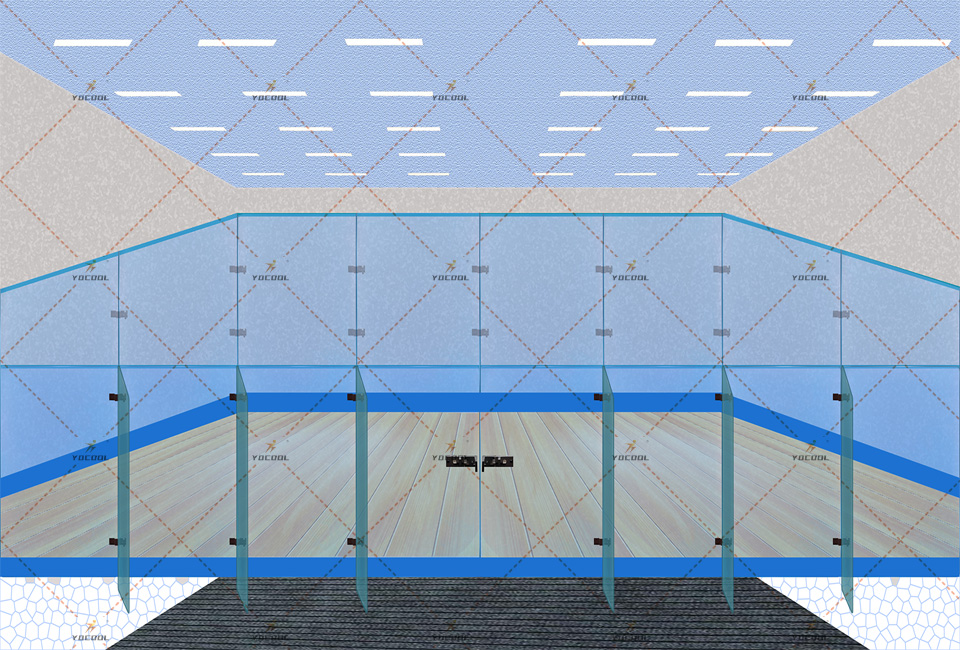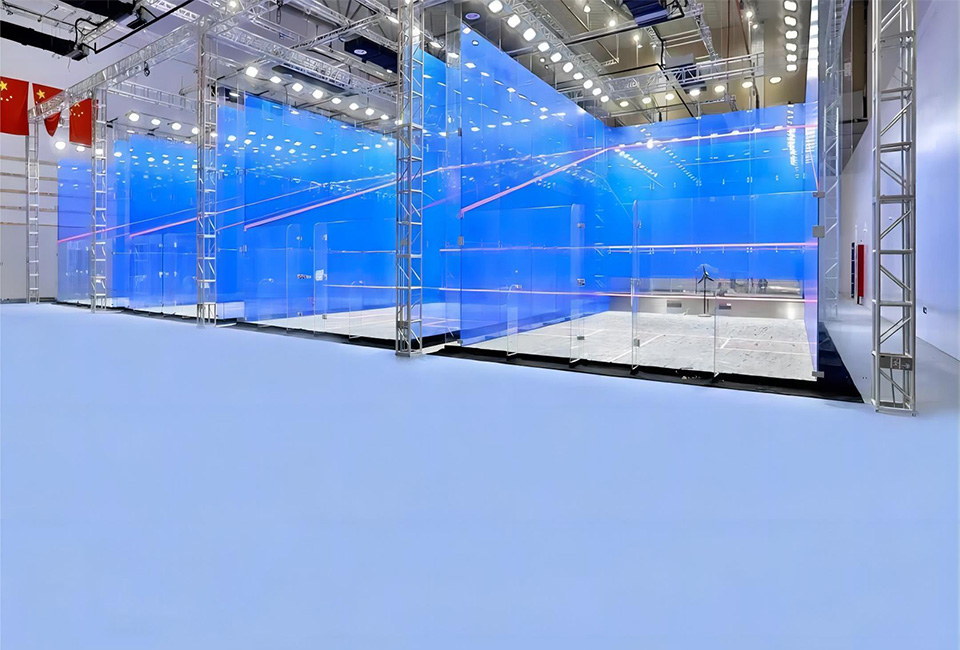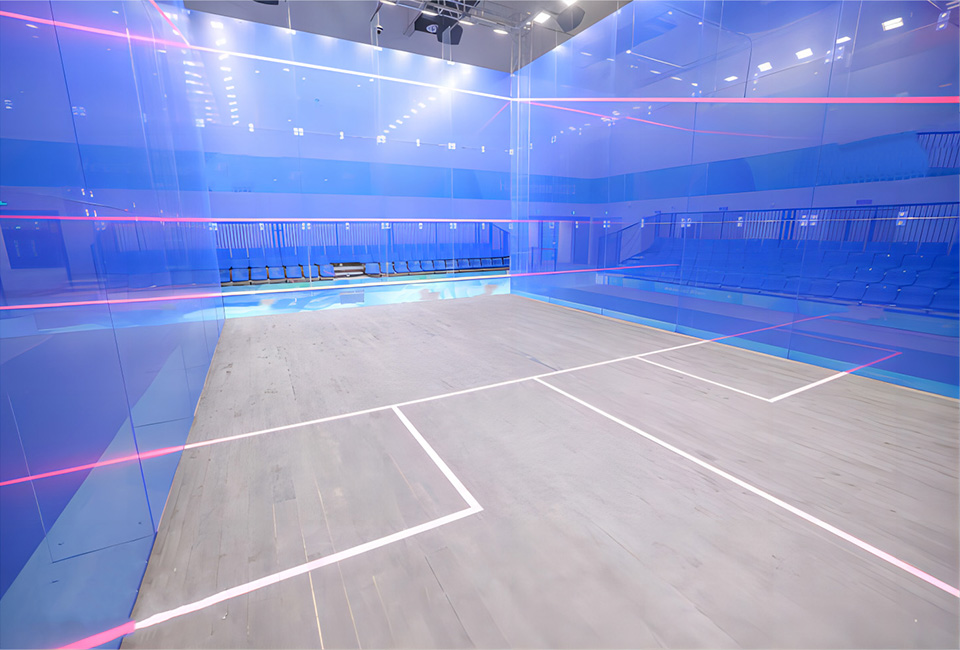

The global surge in padel court installations has transformed this once-niche sport into a mainstream phenomenon. As industry pioneers, Norgo has been at the forefront of court innovation, engineering padel tennis courts that combine performance excellence with aesthetic appeal. This comprehensive guide explores the cutting-edge developments in padel court design, technology, and construction techniques that are shaping the future of the sport.
Squash integrates the characteristics of tennis, badminton, table tennis and other sports in one, which is very good for the exercise of endurance and coordination, and has strong entertainment. The squash hall covers a small area, the sports environment is comfortable, and the competition rules are designed reasonably, which has become a new trend of urban leisure and fitness.
Explore our flagship product: NO.1 All Glass Squash Court
The evolution of padel courts has accelerated dramatically in recent years. What was once a simple outdoor installation has transformed into sophisticated sports architecture. The rise of the panoramic padel court represents the pinnacle of this evolution, with fully transparent glass walls that create immersive spectator experiences while maximizing natural light. These structures account for over 40% of new installations in European countries according to the International Padel Federation.
Hybrid surfaces now dominate professional installations, with advanced polymers providing the perfect balance between ball response and player comfort. Modern paddle tennis courts feature integrated shock absorption systems that reduce joint impact by up to 30% compared to traditional surfaces. The growth of retractable roofing systems has expanded the usability of outdoor padel courts regardless of weather conditions, increasing court utilization rates by up to 240% annually.
Understanding the technical specifications of a professional paddle court is crucial for both installation and maintenance. Below is a comprehensive comparison of standard court specifications versus competition-grade installations:
| Specification | Standard Court | Competition Grade | FIP Standard |
|---|---|---|---|
| Court Dimensions | 10m x 20m | 10m x 20m | 10m x 20m |
| Playing Surface | Artificial turf (8mm) | Hybrid polymeric system (12mm) | Approved artificial turf |
| Wall Height | 3m tempered glass | 4m ultra-clear glass | Min. 3m glass/wire mesh |
| Glass Thickness | 10mm tempered | 12mm laminated safety glass | 10mm+ tempered |
| Surface Shock Absorption | 25-30% | 55-60% | 30% minimum |
| Ball Rebound Consistency | 85-90% | 93-96% | 90%+ required |
| LED Lighting System | 400 lux | 800-1000 lux | 500 lux minimum |
The technical differences between recreational and professional padel tennis courts significantly impact gameplay quality. High-end installations use multi-layer surface systems that combine rubber shock pads with precisely calibrated artificial turf, creating consistent ball bounce characteristics while protecting players' joints. For panoramic padel court installations, laminated safety glass with special anti-glare treatments prevents visual distortion during daytime play.
The architectural approach to padel court construction has evolved into a specialized discipline. Modern paddle courts incorporate advanced drainage systems capable of handling 100mm/hour rainfall without compromising playing conditions. Our proprietary "AirFlow" subsurface technology allows outdoor courts to dry 70% faster than traditional designs, maximizing court availability after adverse weather.
Indoor installations increasingly use acoustic optimization to contain sound within court boundaries, reducing noise transmission between courts by up to 30 decibels. The integration of spectator zones has transformed the viewing experience, particularly in panoramic padel court installations where uninterrupted sightlines create an intimate connection between players and audiences.




Applying our expertise in racquet sports construction, our NO.1 All Glass Squash Court represents the cutting edge in squash facility design. Featuring full tempered glass walls and integrated LED court marking systems, it creates spectacular visual experiences while optimizing gameplay. With advanced sound containment technology and customizable lighting systems, these facilities are transforming urban sports centers worldwide.
Discover how our squash technology is advancing the padel court sector through material science innovation.
The surface layer of a modern padel tennis court is the result of advanced polymer engineering. Norgo's SmartCourt™ surface technology features zone-specific elasticity patterns that provide optimal traction in pivot areas while increasing shock absorption in high-impact zones. The antimicrobial properties integrated into the turf fibers maintain hygienic conditions while resisting degradation from UV exposure.
The glass walls in premium paddle courts undergo specialized treatments to minimize glare while preserving optical clarity. Our DiamondCoat™ nanotechnology surface treatment creates a hydrophobic barrier that repels water and maintains visibility during wet conditions. This same technology finds application in our panoramic padel court installations where all-weather performance is essential.
Q: What materials are recommended for professional-level padel court surfaces?
A: Competition-grade courts require at least 12mm hybrid surfaces combining SBR rubber granules with monofilament polyethylene turf. Our SmartCourt Pro system incorporates dual-layer shock pads that deliver 60% force reduction with FIFA Quality Pro certification.
Q: What glass specifications are required for tournament-approved courts?
A: FIP-sanctioned courts must use minimum 10mm tempered glass with HVHA safety certification. For panoramic installations, we recommend 12-15mm laminated glass with anti-glare treatments to reduce sun interference during play.
Q: What lighting standards should paddle tennis courts meet?
A: Professional facilities require minimum 500 lux uniform illumination. Our LED ProLight systems deliver 800-1000 lux with zero flicker and 90+ CRI, minimizing shadows while providing excellent ball visibility at high speeds.
Q: How does climate affect padel court construction specifications?
A: Temperature variations exceeding 30°C annually require expansion joints every 6 meters and specialized polyurethane adhesives. High-humidity environments need antimicrobial turf infill and aluminum substructures to prevent corrosion.
Q: What's the typical installation timeline for a professional court?
A: From groundbreaking to play-ready takes 12-16 weeks for single court installations. Our prefabrication system reduces this to 8 weeks while maintaining quality standards through controlled factory production.
Q: How frequently should paddle court surfaces be maintained?
A: Professional facilities require bi-weekly grooming and seasonal deep cleaning. Surface resilience testing every 6 months ensures consistent ball rebound characteristics within FIP-approved ranges (90-110cm from 254cm drop height).
Q: What innovations are emerging in panoramic padel court design?
A: The latest designs feature structural glass systems without visible frames, creating truly immersive experiences. Integrated LED court marking replaces painted lines, while smart glass technologies can adjust opacity based on lighting conditions.
Installing world-class padel courts requires meticulous planning and execution. Norgo's 360° Project Management covers every phase from site assessment through post-installation maintenance. Our geotechnical specialists conduct comprehensive soil analysis to determine optimal foundation specifications, which can vary from standard reinforced concrete to specialized helical pile systems in challenging soil conditions.
For club developments and multi-court installations, we provide integrated facility planning that optimizes player flow and maximizes revenue-generating spaces. Our proprietary modeling software simulates player movement patterns and spectator sightlines, ensuring optimal orientation and spacing between courts. The same engineering principles we apply to paddle racquet facilities help create efficient service corridors and viewing areas.
1. International Padel Federation (2023). "Global Court Construction Standards" https://www.padelfip.com/standards
2. Sports Surface Engineering Journal (2023). "Impact Absorption Dynamics in Padel Court Surfaces" https://ssej.org/padel-impact
3. European Architecture Review (2023). "The Stadium Experience: Spectator Integration in Racket Sports Facilities" https://ear.com/stadium-experience
4. Global Sports Technology (2022). "Material Innovations in Court Construction" https://gst.com/material-innovations
5. Journal of Athletic Performance (2023). "Biomechanics of Surface-Tissue Interaction in Court Sports" https://jap.org/biomechanics
6. Padel Business Quarterly (2023). "Economic Models for Commercial Court Operations" https://pbq.com/economic-models
This is the last article
Premium Padel Courts: Custom Designs & Panoramic Views
Premium Paddle Racquet | High-Control Lightweight Design
NO.2 Panoramic Padel Orange Racket - Superior Grip & Durability
High-Performance Industrial Flooring Solutions China Paddle Tennis Court for Sale
High-Performance Industrial Flooring Solutions Durable & Cost-Effective
Homogeneous Transparent Floor – Durable & Stylish Rubber Floor Solutions